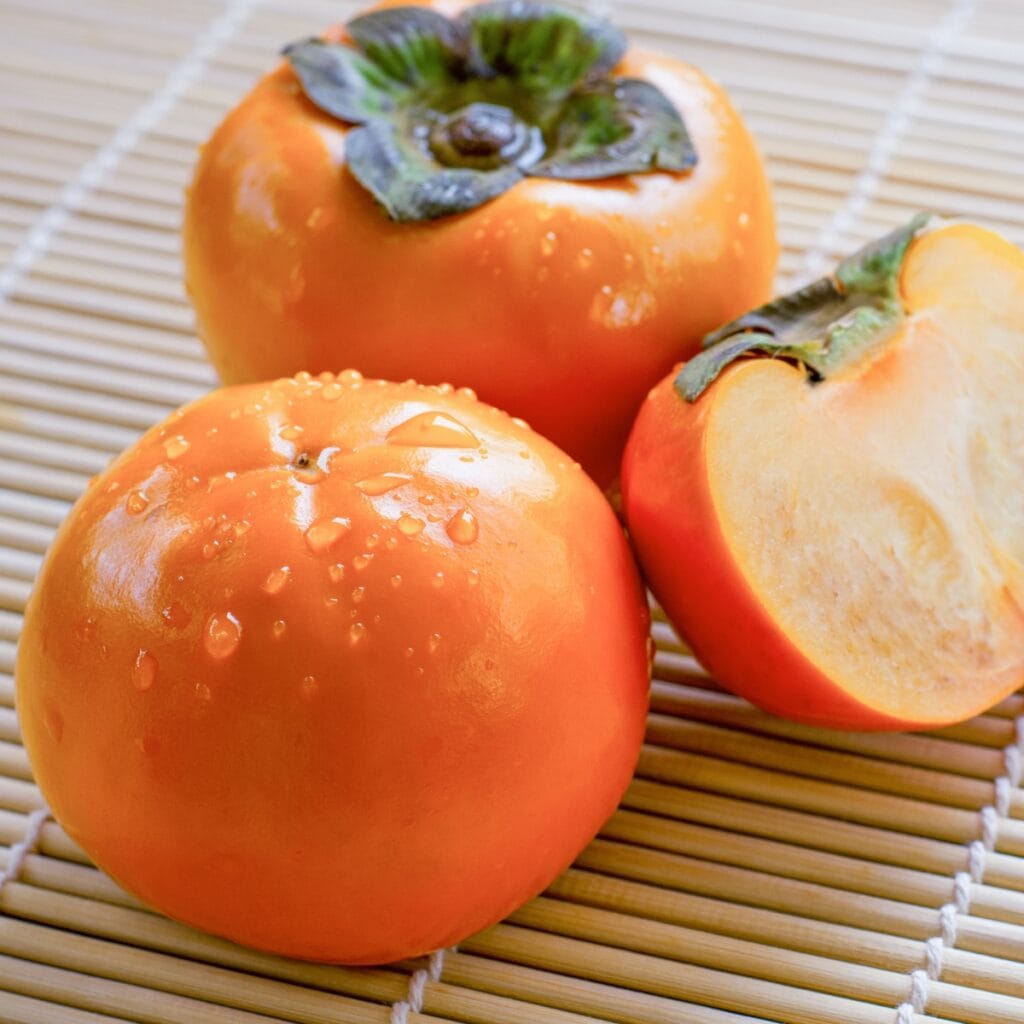Try these different types of persimmons for something a bit unique.
There are two types of people in the world: those who love persimmons, and those who have never tried them.
In case you don’t know, persimmons are small, round fruits with bright orange flesh.

While they may look unassuming, persimmons pack a powerful punch when it comes to flavor.
They can be enjoyed fresh, or used in baked goods, salads, and even savory dishes.
If you’re curious to try them for the first time, here’s everything you need to know about these delicious fruits.
What are Persimmons?
The persimmon is a curious fruit. It’s small and bright orange, with smooth skin that belies its delicate flesh.
And it has a rather unusual flavor: sweetness with just a hint of astringency.
But the most curious thing about the persimmon is its name.
You see, the word “persimmon” comes from the Algonquin word “pasiminan,” which means “dry fruit.”
And yet, despite its name, the persimmon is actually quite moist and juicy.
In fact, it’s one of the most succulent fruits you’ll ever taste.
17 Types of Persimmons
1. Fuyu Persimmons

The name Fuyu means “winter” in Japanese, and this variety of persimmon is named after the season in which it ripens.
Unlike other varieties of persimmon, Fuyus do not need to be peeled before they are eaten.
They can be eaten either fresh or dried, and their flavor has been described as being sweet and crunchy.
2. Eureka Persimmon

The Eureka persimmon is a small, round fruit that ranges in color from yellow to orange.
It has a thin skin and a sweet, pulp that is similar in taste to apricots.
The Eureka persimmon is a popular choice for making jams and preserves, as well as for eating fresh.
However, the fruit can also be used in savory dishes.
3. Chocolate Persimmon

The chocolate persimmon is a variety of the common persimmon.
As the name suggests, this fruit has dark brown or black flesh, and it has a rich, chocolatey flavor.
The chocolate persimmon is smaller than the common persimmon.
It’s often used in baking or as a decoration due to its striking appearance.
4. Hachiya Persimmons

The flesh of the Hachiya persimmon is very soft and jelly-like, and it contains a large number of seeds.
This variety of persimmon is often used in baking, as the flesh can be easily mashed and used as a filling or topping.
It’s also a popular addition to salads, as the sweetness of the fruit compliments the savory flavors of other ingredients.
5. Great Wall Persimmon

The fruit is large and round, with a reddish-orange skin.
The flesh of the fruit is sweet and firm, making it a popular choice for eating fresh or using in recipes.
It’s named after the iconic structure in China.
It’s said to be one of the few varieties of persimmon that can be seen from the top of the wall.
6. Giombo Persimmon

The Giombo persimmon is a small, round fruit with a deep red color and a slightly sweet flavor.
It’s often used in desserts, such as pies and cakes. It can also be eaten fresh or made into jams and chutneys.
It’s usually more elongated compared to the more common version, making it easy to spot.
7. Maekawa Jiro

This variety is named after the maekawa, or Japanese beech tree, which is its main source of food.
It’s a small persimmon, typically no more than four centimeters in diameter.
It’s round and slightly flattened, with bright orange skin and a smooth, pulp-like flesh.
The fruit has a sweet-tart flavor and a firm texture.
8. Sheng Persimmon

The skin of the Sheng persimmon is thin and smooth, and the flesh is sweet and juicy.
This persimmon variety is often used in Chinese cooking, and it can also be eaten fresh.
The Sheng persimmon is an excellent source of Vitamin C, and it also contains a good amount of fiber.
9. Saijo Persimmon

The Saijo persimmon is a variety of the fruit that is indigenous to the Saijo region of Japan.
The persimmon is typically spherical or oblate in shape and has a yellow-orange color.
The Saijo persimmon is different in that it is smaller and more oval-shaped with a bright red hue.
It’s also sweeter and juicier than its counterparts.
10. Midia Persimmon

The Midia persimmon is distinct from other persimmons in a few ways.
Most notably, it has a reddish-orange color and a slightly flattened shape.
It’s said to have a sweeter flavor than other varieties, making it a popular choice for eating out of hand.
The Midia persimmon is also believed to have numerous health benefits, including being high in antioxidants and fiber.
11. Jiro Persimmon

The Jiro variety is characterized by its flattened shape and reddish-brown color.
The skin of the fruit is thin and easy to peel, and the flesh is sweet and tangy.
Jiro persimmons are typically eaten fresh, but they can also be used in baking or made into jams and chutneys.
12. Izu Persimmon

The Izu persimmon gets its name from the area where it originated, Izu.
This particular area in Japan is famous for growing some of the tastiest and most sought-after fruits in the country.
While most persimmons are sweet, the Izu variety is known for being both sweet and tart.
It’s also especially juicy, making it a favorite among those who enjoy a good bite of fruit.
13. Rojo Brillante Persimmon

This variety of persimmon is bright red, and its flesh is a deep, rich orange.
It’s also a bit smaller than other varieties of persimmon.
But don’t let its size fool you – this little fruit packs a delicious punch.
The Rojo brillante is sweet and juicy, with a hint of spice.
14. Sharon Persimmon

The Sharon persimmon is round and orange, with smooth skin that does not need to be peeled.
It’s crunchy and sweet, with a delicate flavor that has been likened to honey.
It’s also often used in desserts, such as pies and cakes.
15. Suruga Persimmon

The Suruga persimmon is a variety of persimmon that is native to Japan.
It’s considered one of the sweeter varieties of persimmon, and it’s often used in desserts and juices.
The fruit is oval in shape and has a deep red color.
The skin of the fruit is thin and easy to peel. The flesh of the Suruga persimmon is firm and has a sweet flavor.
16. Tanenashi Persimmon

Tanenashi persimmons are a variety of persimmon that are native to Japan.
The name “tanenashi” literally means “without seed,” which is fitting because this type of persimmon does not contain any seeds.
Tanenashi persimmons are small and round, with a deep orange color.
They have a sweet, slightly tangy flavor that is delicious both fresh and dried.
17. Triumph Persimmon

The Triumph persimmon is a variety of persimmon that is known for its sweet taste and easy-to-eat flesh.
It’s also a great addition to any fruit bowl or as a tasty snack on its own.
Plus, you can use it in both sweet and savory dishes.
This variety of persimmon is also one of the easiest to grow, making it a great choice for those who are new to gardening.











